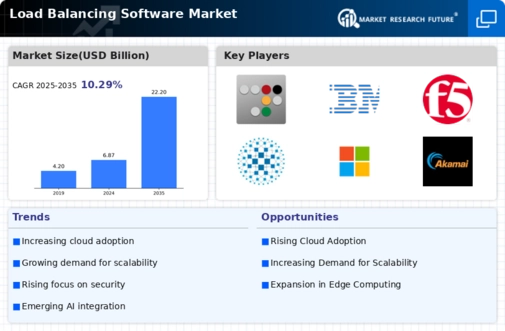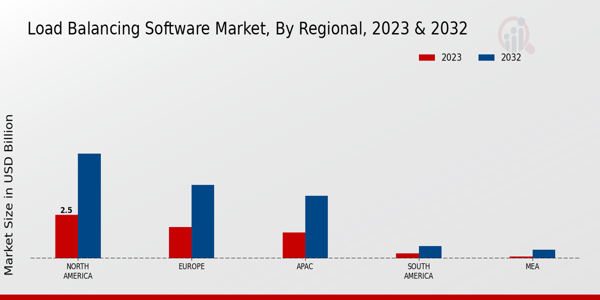Market Growth Projections
The Global Load Balancing Software Market Industry is poised for substantial growth, with projections indicating a market value of 6.87 USD Billion in 2024 and an anticipated increase to 22.2 USD Billion by 2035. This growth trajectory suggests a compound annual growth rate of 11.24% from 2025 to 2035, reflecting the increasing reliance on load balancing solutions across various sectors. The market dynamics are influenced by factors such as cloud adoption, cybersecurity concerns, and the expansion of e-commerce. As organizations continue to prioritize performance and reliability, the demand for load balancing software is expected to rise, positioning the industry for a promising future.
Cloud Adoption and Migration
The ongoing shift towards cloud computing significantly influences the Global Load Balancing Software Market Industry. As organizations migrate their workloads to cloud environments, the necessity for robust load balancing solutions becomes evident. These solutions facilitate seamless distribution of traffic across multiple servers, enhancing reliability and performance. The increasing adoption of hybrid and multi-cloud strategies further amplifies this need, as businesses seek to optimize resource utilization and minimize downtime. This trend is expected to contribute to a compound annual growth rate of 11.24% from 2025 to 2035, indicating a robust future for load balancing software in cloud environments.
Increased Focus on Cybersecurity
In the context of the Global Load Balancing Software Market Industry, the heightened emphasis on cybersecurity plays a crucial role in shaping market dynamics. As cyber threats become more sophisticated, organizations are compelled to implement advanced security measures, including load balancing solutions that can mitigate risks. Load balancers not only distribute traffic but also provide essential security features such as DDoS protection and SSL termination. This dual functionality enhances the appeal of load balancing software, as businesses prioritize both performance and security. The integration of security features into load balancing solutions is likely to drive market growth, as organizations seek comprehensive solutions to safeguard their digital assets.
Emergence of IoT and Edge Computing
The rise of the Internet of Things (IoT) and edge computing is reshaping the Global Load Balancing Software Market Industry. As more devices connect to the internet, the volume of data generated increases exponentially, necessitating efficient traffic management. Load balancing solutions are essential for distributing workloads across edge devices and cloud resources, ensuring low latency and high availability. This trend is particularly relevant as industries such as manufacturing and healthcare adopt IoT technologies to enhance operational efficiency. The integration of load balancing software with IoT and edge computing strategies is likely to drive innovation and growth within the market.
Growth of E-commerce and Online Services
The expansion of e-commerce and online services significantly impacts the Global Load Balancing Software Market Industry. With the increasing number of consumers turning to online platforms for shopping and services, businesses are under pressure to ensure their websites remain responsive and available. Load balancing software plays a pivotal role in managing traffic spikes during peak shopping seasons, ensuring a seamless user experience. As e-commerce continues to thrive, the demand for effective load balancing solutions is expected to rise correspondingly. This trend underscores the necessity for businesses to invest in robust load balancing software to maintain competitiveness in the digital marketplace.
Rising Demand for Application Performance
The Global Load Balancing Software Market Industry experiences a surge in demand driven by the need for enhanced application performance. Organizations are increasingly reliant on web applications for their operations, necessitating efficient load balancing to ensure optimal performance. As businesses expand their digital footprint, the need for reliable software that can distribute traffic effectively becomes paramount. In 2024, the market is valued at 6.87 USD Billion, reflecting the growing recognition of load balancing as a critical component of IT infrastructure. This trend is expected to continue, with projections indicating a market growth to 22.2 USD Billion by 2035, highlighting the importance of application performance in driving market dynamics.












